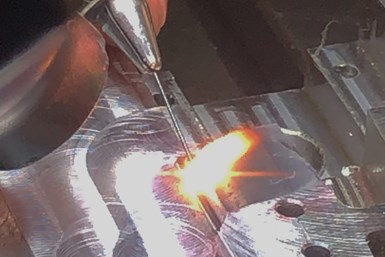Established Laser Services Support Global Mold Builders
Since its founding in 2004, Precision Laser Technology has upheld its commitment to high-quality, reliable laser graving services, including tool metallurgy, laser welding and texturing and direct part making.

Photo Credit: Precision Laser Technology
Precision Laser Technology (PLT) was launched in 2004, correlating with the increasing development of laser engraving services for the injection and blow molding industry. Located in Upstate New York, PLT quickly gained a reputation for high-quality, reliable services within the caps and closures industry, partnering with reputable mold manufacturers of consumable, cosmetic and healthcare closures. As laser technology advanced and customers sought more refined molding solutions, PLT’s services expanded to include Direct Part Marking of molded plastics, Laser Texturing of complex patterns and Laser Welding for the repair and reconditioning of mold components.
To assist customers with mold maintenance and repairs that offer durability, and to ensure a quick response, PLT operates four laser welding stations, plus a Micro-TIG station, ranging up to 300W and optimized with multiple axes systems, boom extensions and CNC programming as well as tilting and swiveling optics. PLT services mold with a variety of tool metals including S7, H13, stainless steel, 17-4, P20, A2, D2, M2, Elmax, Stavax, AL—including QC10—and BeCu, including MoldMax and MoldStar.
Committed to the highest quality of service, PLT relies on its vast experience and expertise in tool metallurgy and laser welding, employing techniques proven to ensure the repair’s ultimate success. PLT stocks a library of wires ranging in size (0.005-0.040”) and materials to produce the most useful weld, whether to match steel type and hardness for texturing or to better control buildup and heat-affected zones (HAZ).
Recently, PLT was approached by a customer experiencing a high wear rate on medical cores due to the mold’s design and heavy workload. After conducting trials with the customer, PLT says it was able to design a unique welding process and recommend a filler wire that provided adequate hardness, minimal post work and smallest HAZ. The maintenance rate of the cores was reduced by 66%.
Related Content
-
Precision Welding Services Offer Rapid Turnaround Mold Repair and Reduced Molder Downtime
X-Cell Tool & Mold relies on outsourced, high-quality welding repairs from Lewis-Bawol Welding to ensure its customers' molds are back in production quickly and affordably.
-
What You Should Know About Injection Mold Safety Straps
Every mold should have one in order to be safe and OSHA compliant.
-
Portable Low-Heat, Non-Arcing Resistance Welder for Mold Repair
Rocklin’s user-friendly MoldMender Micro Welder delivers simple and cost-effective localized repair in-house with precision and versatility, enhancing mold and die durability and reducing disassembly and downtime.











.jpg;maxWidth=300;quality=90)
.jpg;maxWidth=970;quality=90)